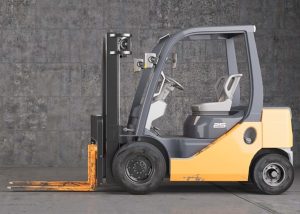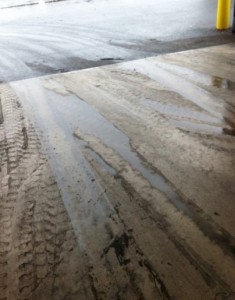Hello Guest,
 Food processors can spend a large amount of time and effort trying to clean surfaces that have been contaminated but often overlook how contamination can be minimised or stopped in the first place, at its source.
Food processors can spend a large amount of time and effort trying to clean surfaces that have been contaminated but often overlook how contamination can be minimised or stopped in the first place, at its source.
80% of contamination entering your critical environment does so via footwear or wheels. (Source: ISSA). Therefore, controlling contamination at or near floor level is an essential and fundamental part of any risk management policy or HACCP plan.
Here are 10 things you should know before looking at options to control contamination or cross contamination via the floors in your factory:
1. The dirt you didn’t know about: Proactive companies that have captured and measured the volume of dirt entering their facilities have found it to be in excess of 20kg per week through one main thoroughfare! Just imagine taking 20kg of dirt and spreading it finely throughout your facility and getting your forklifts to grind it to powder so it settles on finished goods and equipment – yet that is what is happening every week in many factories without people realising!
 2. What you can’t see: Dirt you can see is relatively easy to manage, but what about what you can’t see, the bacteria and other unwanted microorganisms that will happily hitch a ride on footwear or wheels? A report from the Ministry of Primary Industries states that; “Major incidents involving Listeria and other pathogens have been traced to floors (for example) where Listeria has formed biofilms and been unable to be removed. Listeria may be transferred from these sites by the likes of trolley wheels. Floors and drains should always be considered to be contaminated with Listeria.”
2. What you can’t see: Dirt you can see is relatively easy to manage, but what about what you can’t see, the bacteria and other unwanted microorganisms that will happily hitch a ride on footwear or wheels? A report from the Ministry of Primary Industries states that; “Major incidents involving Listeria and other pathogens have been traced to floors (for example) where Listeria has formed biofilms and been unable to be removed. Listeria may be transferred from these sites by the likes of trolley wheels. Floors and drains should always be considered to be contaminated with Listeria.”
3. Sanitation controls: Foot bath wells or foot bath mats are ok in some situations but the limitations are the fact that the surrounding areas often get moisture pooling which in turn gets tracked further into facilities. They are limited to only those wearing gumboots (visitors with dress shoes can’t practically use these) and also they won’t work for anything wheeled like trolleys to pass over. Doorway foamers are an option for sanitation between zones that will work for wheeled equipment, however like footbaths, they leave the surrounding area wet and slippery.
4. Footwear cleaning: Boot scrub or cleaning stations are only effective for cleaning the tops and sides of the boots. The underside of boots, especially those with a deep tread, are very difficult to clean effectively whilst standing at a boot scrub station.
5. Having an option is unreliable: If your contamination control from a pedestrian point of view is reliant on the likes of automatic cleaning machines or stationary boot scrubbers, make sure these aren’t standalone units that become an optional choice for the user as inevitably they won’t be used consistently. Make this a fundamental part of your factory entrance-way that can’t be bypassed.
 6. Contamination in the form of moisture: Moisture transfer from a wet area to a dry area is never a good idea for the following reasons:
6. Contamination in the form of moisture: Moisture transfer from a wet area to a dry area is never a good idea for the following reasons:
a. There are dry tolerant bacteria that can be found in dry areas of the factory – these are often viable but not active until they are exposed to moisture
b. Moisture coming into warehouses on a wet day from forklifts or trucks can cause health and safety issues, both for pedestrians with risk of slips and falls as well as forklifts with potential loss of traction.
7. Engineer’s workshops: These are often in an integral part of the food factory with direct access to processing environments. Standard entrance mats remove some of the soil but the likes of swarf entrenched in the tread of the boots can be difficult to remove and is a potential hazard in the processing environment.
8. Cost of cleaning: With contamination being inadvertently tracked throughout factory and warehouse floors, the associated cost is the cleaning bill – often either staff or contractors are spending a lot of time and resources cleaning floors. This could be significantly reduced if an effective contamination control system was in place.
 9. Boot exchanges: Often in new facilities, especially in the dairy industry, boot exchanges with a physical barrier are seen as the only fail safe way to stop contamination being transferred between zones. The downside of these are that they are expensive to install and maintain as they require a separate zone or room that has to be cleaned each day and separate footwear required in all sizes, but that is only a small cost when you consider the ongoing downtime. Say you had 50 staff all going through a common entrance 8-10 times a day, each time taking between one and two minutes, that is over 11 hours lost productivity EVERY DAY! This was proven recently by a food manufacturer in New South Wales that stopped using boot covers in favour of an alternative solution and saved over 13 hours a day in lost production time, not to mention the cost savings of over 1000 pairs of boot covers a day!
9. Boot exchanges: Often in new facilities, especially in the dairy industry, boot exchanges with a physical barrier are seen as the only fail safe way to stop contamination being transferred between zones. The downside of these are that they are expensive to install and maintain as they require a separate zone or room that has to be cleaned each day and separate footwear required in all sizes, but that is only a small cost when you consider the ongoing downtime. Say you had 50 staff all going through a common entrance 8-10 times a day, each time taking between one and two minutes, that is over 11 hours lost productivity EVERY DAY! This was proven recently by a food manufacturer in New South Wales that stopped using boot covers in favour of an alternative solution and saved over 13 hours a day in lost production time, not to mention the cost savings of over 1000 pairs of boot covers a day!
10. If you are not yet convinced…that controlling the contamination of your floors is essential, it is in fact a requirement for conformance to GMP and Risk Management Systems – such as HACCP – to have measures in place to reduce the risk of contamination. Additionally, regulatory bodies such as MPI and other auditing teams for customer imposed audits, all recognise the importance of managing contamination by implementing an effective control system that limits the transfer of contaminants between zones.
To discuss an innovative way to easily control all these risks and challenges, please contact us today. We’ll give you ultimate peace of mind that you can now manage this effectively in your factory.
